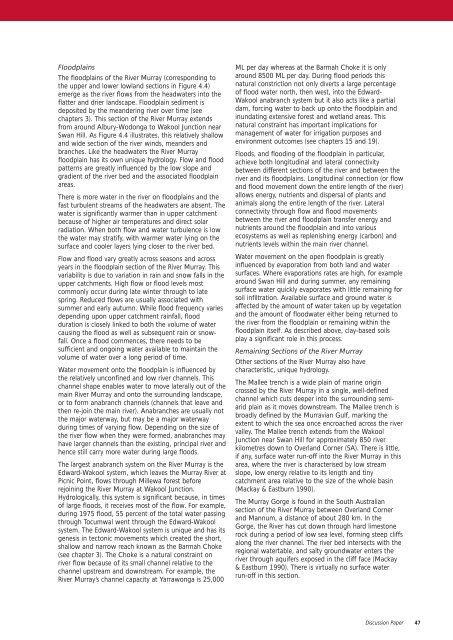Discussion Paper - Part A - Victorian Environmental Assessment ...
Discussion Paper - Part A - Victorian Environmental Assessment ...
Discussion Paper - Part A - Victorian Environmental Assessment ...
- No tags were found...
Create successful ePaper yourself
Turn your PDF publications into a flip-book with our unique Google optimized e-Paper software.
FloodplainsThe floodplains of the River Murray (corresponding tothe upper and lower lowland sections in Figure 4.4)emerge as the river flows from the headwaters into theflatter and drier landscape. Floodplain sediment isdeposited by the meandering river over time (seechapters 3). This section of the River Murray extendsfrom around Albury-Wodonga to Wakool Junction nearSwan Hill. As Figure 4.4 illustrates, this relatively shallowand wide section of the river winds, meanders andbranches. Like the headwaters the River Murrayfloodplain has its own unique hydrology. Flow and floodpatterns are greatly influenced by the low slope andgradient of the river bed and the associated floodplainareas.There is more water in the river on floodplains and thefast turbulent streams of the headwaters are absent. Thewater is significantly warmer than in upper catchmentbecause of higher air temperatures and direct solarradiation. When both flow and water turbulence is lowthe water may stratify, with warmer water lying on thesurface and cooler layers lying closer to the river bed.Flow and flood vary greatly across seasons and acrossyears in the floodplain section of the River Murray. Thisvariability is due to variation in rain and snow falls in theupper catchments. High flow or flood levels mostcommonly occur during late winter through to latespring. Reduced flows are usually associated withsummer and early autumn. While flood frequency variesdepending upon upper catchment rainfall, floodduration is closely linked to both the volume of watercausing the flood as well as subsequent rain or snowfall.Once a flood commences, there needs to besufficient and ongoing water available to maintain thevolume of water over a long period of time.Water movement onto the floodplain is influenced bythe relatively unconfined and low river channels. Thischannel shape enables water to move laterally out of themain River Murray and onto the surrounding landscape,or to form anabranch channels (channels that leave andthen re-join the main river). Anabranches are usually notthe major waterway, but may be a major waterwayduring times of varying flow. Depending on the size ofthe river flow when they were formed, anabranches mayhave larger channels than the existing, principal river andhence still carry more water during large floods.The largest anabranch system on the River Murray is theEdward-Wakool system, which leaves the Murray River atPicnic Point, flows through Millewa forest beforerejoining the River Murray at Wakool Junction.Hydrologically, this system is significant because, in timesof large floods, it receives most of the flow. For example,during 1975 flood, 55 percent of the total water passingthrough Tocumwal went through the Edward-Wakoolsystem. The Edward-Wakool system is unique and has itsgenesis in tectonic movements which created the short,shallow and narrow reach known as the Barmah Choke(see chapter 3). The Choke is a natural constraint onriver flow because of its small channel relative to thechannel upstream and downstream. For example, theRiver Murray’s channel capacity at Yarrawonga is 25,000ML per day whereas at the Barmah Choke it is onlyaround 8500 ML per day. During flood periods thisnatural constriction not only diverts a large percentageof flood water north, then west, into the Edward-Wakool anabranch system but it also acts like a partialdam, forcing water to back up onto the floodplain andinundating extensive forest and wetland areas. Thisnatural constraint has important implications formanagement of water for irrigation purposes andenvironment outcomes (see chapters 15 and 19).Floods, and flooding of the floodplain in particular,achieve both longitudinal and lateral connectivitybetween different sections of the river and between theriver and its floodplains. Longitudinal connection (or flowand flood movement down the entire length of the river)allows energy, nutrients and dispersal of plants andanimals along the entire length of the river. Lateralconnectivity through flow and flood movementsbetween the river and floodplain transfer energy andnutrients around the floodplain and into variousecosystems as well as replenishing energy (carbon) andnutrients levels within the main river channel.Water movement on the open floodplain is greatlyinfluenced by evaporation from both land and watersurfaces. Where evaporations rates are high, for examplearound Swan Hill and during summer, any remainingsurface water quickly evaporates with little remaining forsoil infiltration. Available surface and ground water isaffected by the amount of water taken up by vegetationand the amount of floodwater either being returned tothe river from the floodplain or remaining within thefloodplain itself. As described above, clay-based soilsplay a significant role in this process.Remaining Sections of the River MurrayOther sections of the River Murray also havecharacteristic, unique hydrology.The Mallee trench is a wide plain of marine origincrossed by the River Murray in a single, well-definedchannel which cuts deeper into the surrounding semiaridplain as it moves downstream. The Mallee trench isbroadly defined by the Murravian Gulf, marking theextent to which the sea once encroached across the rivervalley. The Mallee trench extends from the WakoolJunction near Swan Hill for approximately 850 riverkilometres down to Overland Corner (SA). There is little,if any, surface water run-off into the River Murray in thisarea, where the river is characterised by low streamslope, low energy relative to its length and tinycatchment area relative to the size of the whole basin(Mackay & Eastburn 1990).The Murray Gorge is found in the South Australiansection of the River Murray between Overland Cornerand Mannum, a distance of about 280 km. In theGorge, the River has cut down through hard limestonerock during a period of low sea level, forming steep cliffsalong the river channel. The river bed intersects with theregional watertable, and salty groundwater enters theriver through aquifers exposed in the cliff face (Mackay& Eastburn 1990). There is virtually no surface waterrun-off in this section.<strong>Discussion</strong> <strong>Paper</strong>47
















